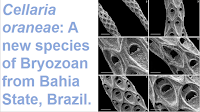Bryozoans are a phylum of suspension feeding Lophotrochozoans found in all aquatic environments from lakes and rivers to the deep oceans. Bryozoans have a simple bodyplan, with a ciliated tentacle crown called a lophophore, which is used to collect food, and a u-shaped digestive tract, all of which is contained within a thick body wall, the cystid, which is often mineralized. The majority of Bryozoans are colonial with linked cystids, often forming elaborate structures, as well as connected digestive tracts, which enable them to share food.
In a paper published in the journal Marine Biodiversity on 21 February 2024, Thomas Schwaha of the Department of Evolutionary Biology at the University of Vienna, Daniela Zeppilli of Biologie et Écologie des Ecosystèmes marins Profonds at the University of Brest, Alberto González‑Casarrubios of the Department of Biodiversity, Ecology and Evolution at the Complutense University of Madrid, and Diego Cepeda of the Department of Biology and Research Centre for Biodiversity and Global Change at the Autonomous University of Madrid, describe a new species of solitary Bryozoan from the sediments around Fani Maoré, a recently discovered submarine volcano off eastern Mayotte, a French overseas department in the Comoros Islands of the southern Indian Ocean.
Visible fauna was not present around Fani Maoré, but sediment samples recovered from the site were found to be rich in meiofauna (small benthic Invertebrates), with an unknown Aethozoid Bryozoan being the most abundant non-Nematode species.
Aethozoids are a small and poorly understood group of non-mineralized, usually solitary, Bryozoans, with only five previously described species in four genera; Aethozoon pellucidum, from the northeast Atlantic, and recently the deep Kuril-Kamchatka Trench at depths of greater that 7000 m, Aethozooides uraniae from the deep-sea hypersaline anoxic Urania basin of the eastern Mediterranean, Franzenella limicola from the shallow Baltic, and Solella radicans and Solella monniotae from the deep North Atlantic.
The new species is placed in the genus Aethozoon and given the specific name flavum, the Latin word for yellow, in reference to the colour of the examined specimens. These are between 1787 μm and 2996 μm in length (average length 2281 μm), with a wider basal section 295 μm to 392 μm in length which contains the containing gonads, digestive tract, retractor muscles and funicular system. Two types of appendage are present at the base, kenozooidal cystid appendages, which appear tp be used for asexual reproduction; with examined specimens having a budding stages attached, and the related Aethozooides uraniae also produces buds from kenozooidal cystid appendages. Aethozoon flavum is also apparently capable of sexual reproduction, with all examined specimens being similtaneous hermaphrodites. Not all specimens of Aethozoon flavum had kenozooidal cystid appendages, while some had two. The other type of appendages are known as non-kenozooidal cystid appendages, and are less clear in purpose, but may be remnants of former attachment to a parent zooid.
See also...









